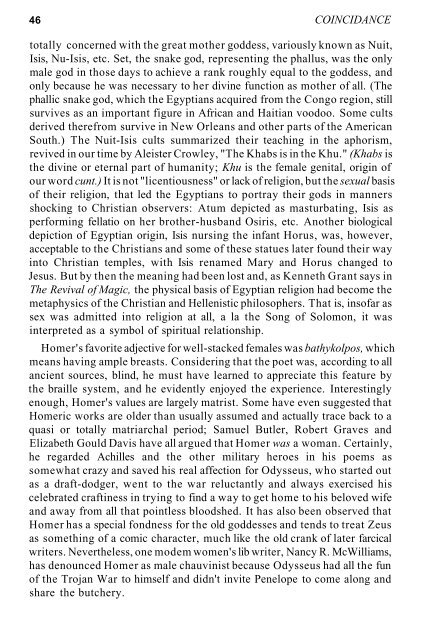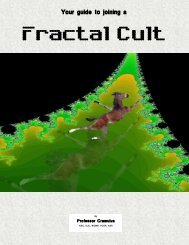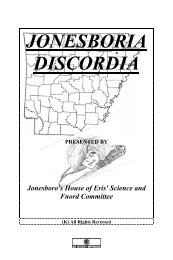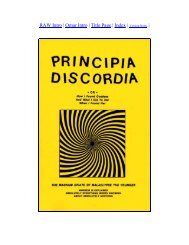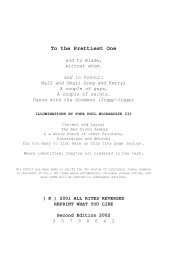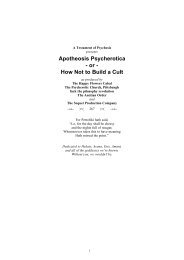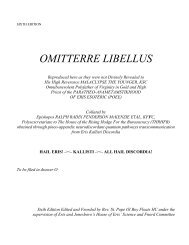Coincidance - Principia Discordia
Coincidance - Principia Discordia
Coincidance - Principia Discordia
You also want an ePaper? Increase the reach of your titles
YUMPU automatically turns print PDFs into web optimized ePapers that Google loves.
46 COINCIDANCE<br />
totally concerned with the great mother goddess, variously known as Nuit,<br />
Isis, Nu-Isis, etc. Set, the snake god, representing the phallus, was the only<br />
male god in those days to achieve a rank roughly equal to the goddess, and<br />
only because he was necessary to her divine function as mother of all. (The<br />
phallic snake god, which the Egyptians acquired from the Congo region, still<br />
survives as an important figure in African and Haitian voodoo. Some cults<br />
derived therefrom survive in New Orleans and other parts of the American<br />
South.) The Nuit-Isis cults summarized their teaching in the aphorism,<br />
revived in our time by Aleister Crowley, "The Khabs is in the Khu." (Khabs is<br />
the divine or eternal part of humanity; Khu is the female genital, origin of<br />
our word cunt.) It is not "licentiousness" or lack of religion, but the sexual basis<br />
of their religion, that led the Egyptians to portray their gods in manners<br />
shocking to Christian observers: Atum depicted as masturbating, Isis as<br />
performing fellatio on her brother-husband Osiris, etc. Another biological<br />
depiction of Egyptian origin, Isis nursing the infant Horus, was, however,<br />
acceptable to the Christians and some of these statues later found their way<br />
into Christian temples, with Isis renamed Mary and Horus changed to<br />
Jesus. But by then the meaning had been lost and, as Kenneth Grant says in<br />
The Revival of Magic, the physical basis of Egyptian religion had become the<br />
metaphysics of the Christian and Hellenistic philosophers. That is, insofar as<br />
sex was admitted into religion at all, a la the Song of Solomon, it was<br />
interpreted as a symbol of spiritual relationship.<br />
Homer's favorite adjective for well-stacked females was bathykolpos, which<br />
means having ample breasts. Considering that the poet was, according to all<br />
ancient sources, blind, he must have learned to appreciate this feature by<br />
the braille system, and he evidently enjoyed the experience. Interestingly<br />
enough, Homer's values are largely matrist. Some have even suggested that<br />
Homeric works are older than usually assumed and actually trace back to a<br />
quasi or totally matriarchal period; Samuel Butler, Robert Graves and<br />
Elizabeth Gould Davis have all argued that Homer was a woman. Certainly,<br />
he regarded Achilles and the other military heroes in his poems as<br />
somewhat crazy and saved his real affection for Odysseus, who started out<br />
as a draft-dodger, went to the war reluctantly and always exercised his<br />
celebrated craftiness in trying to find a way to get home to his beloved wife<br />
and away from all that pointless bloodshed. It has also been observed that<br />
Homer has a special fondness for the old goddesses and tends to treat Zeus<br />
as something of a comic character, much like the old crank of later farcical<br />
writers. Nevertheless, one modem women's lib writer, Nancy R. McWilliams,<br />
has denounced Homer as male chauvinist because Odysseus had all the fun<br />
of the Trojan War to himself and didn't invite Penelope to come along and<br />
share the butchery.


